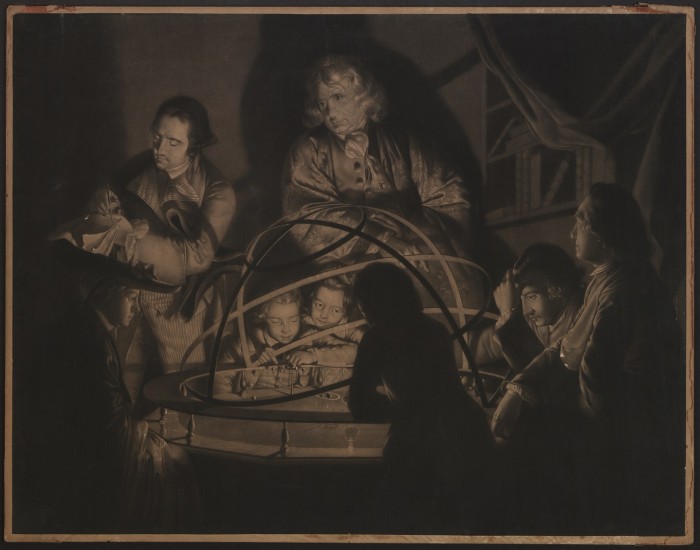Mezzotint is an intaglio process, and is easy to recognise thanks to the distinctive way the image is revealed through lighter tones emerging from a black background. It was particularly important in England for the reproduction of portraits, and was used extensively in the eighteenth and nineteenth centuries.
History
The first steps in the development of mezzotint were made by German, Ludwig con Siegen in 1642. He used a fine roulette and worked from light to dark rather than the dark to light enabled by the development of the rocking tool in the 1650s (credited to Price Rupert).
After settling in England in 1660, Prince Rupert demonstrated the mezzotint technique to John Evelyn who made it public in his 1662 Sculptura, or the History and Art of Chalcogaphy and Engraving in Copper. Rupert also instructed William Sherwin who made the first dated English mezzotint in 1669.
The first English mezzotinter to establish an international reputation was John Smith, who produced his first mezzotints in 1683. Largely thanks to Smith, the mezzotint became a serious competitor to the more traditional engraved portrait. The technique became known as la manière anglaise.
The best mezzotinters were in demand from portrait painters to reproduce their paintings both for publicity purposes and the money to be made from the prints.
Portraits were the most popular subject for mezzotint, but towards the end of the eighteenth century there was also a flourishing tradition of animal subjects. The nineteenth century also saw J.M.W. Turner and John Constable produce mezzotints, with Constable producing some of the finest English mezzotints in twenty-two plates in his Various Subjects of Landscape, 1883.

Mezzotint After Joseph Wright of Derby, ‘A Philosopher giving that Lecture on the Orrery, in which a Lamp is Put in the Place of the Sun’, Late 18th Century. Inv 11792 [1]
Technique
Firstly the plate is grounded (systematically roughened with a rounded blade with cutting teeth known was a rocker). The blade is held at right angles to the plate and rocked repeatedly over the surface. This has to be repeated as many as forty times in order to result in a uniform ground. In this state the plate holds a lot of ink and prints a rich black.
The engraver then smooths the away the raised roughened metal in proportion to the lightness of tone required. Dark grey could be achieved with gentle burnishing, while pure white would require the burr to be completely scraped away and burnished until there is no trace of the teeth from the rocker on the copper plate. The pale grey areas of a mezzotint are the best place to see the characteristic straight lines of the rocker. This process was usually left to a professional mezzotinter, but was also probably occasionally attempted by non-professionals. The inking and printing of the plate was particularly complicated and the more densely worked the plate the more complicated to ink. Some mezzotints could only be produced at the rate of eight to ten impressions a day.
Furthermore, the burr is quickly worn down, limiting the number of impressions that can be taken with the depth of tone associated with the mezzotint. Various methods were employed to overcome this; professionals often reground worn parts of the plate to refresh it, and the emergence of steel plates in the nineteenth century increased the lifespan of the plate, although the image was less rich. Leading eighteenth century mezzotinter, Valentine Green came up with another solution and limited the number of proofs to fifty impressions and doubled their price.
Depending on the skills of the printer, plates could be made to last for more impressions before wearing out. Quality printers were sometimes specifically mentioned in contracts between artists or publishers and an engraver.
In the nineteenth century mezzotint was also often combined with other processes, usually etching, where the heavy lines were etched before the plate was grounded.